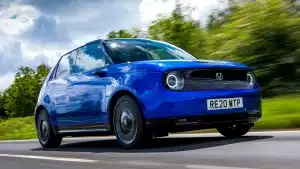Verdict
The i10 has long been one of our favourite small cars, but in terms of quality, usability and sophistication the third generation version is far and away the best. However, to achieve this Hyundai has increased the size of the i10 to the point that it’s starting to encroach on supermini territory. Compared with its predecessor the i10 Mk3 is 20mm wider and its wheelbase is 40mm longer, which results in a useful amount of extra space for passengers, especially those in the back seats. It’s still a small car however; a Ford Fiesta is 40cm longer and 5.5cm wider, for example. The i10 also isn’t an especially cheap car considering its size, but Hyundai has struck a good compromise between compact external dimensions and generous cabin space, plus you get a lot of big-car kit for your cash. Sure there are cheaper options, but when it comes to all-round usability, comfort and safety the tiny i10 towers above its rivals.
There’s so much to like about city cars, especially many modern ones, which are more capable than ever. It isn’t that long since these smallest of vehicles were cramped, basic, noisy, slow, and uncomfortable on longer journeys. Yet the latest breed combine the expected low running costs with excellent refinement with big-car comfort and safety tech, along with a greater level of performance.
Compact dimensions make them a doddle to park, while agility is enhanced by their relatively low weight. Sadly, however, city cars are an endangered species, because the amount of expensive tech they need comply with safety and emissions regulations is making them less profitable for manufacturers.
More reviews
One of the few companies to stick with the segment is Hyundai with its i10, which arrived in first-generation form in 2008. We loved that car and the Mk2 of 2014 was even better. When the i10 Mk3 arrived in 2020 we were even more impressed with its breadth of talents, and the good news is that it makes just as great a buy on the used market.

History
The third-generation Hyundai i10 reached UK showrooms in January 2020, available only as a five-door hatchback and priced from £12,495. The range was pretty simple, with buyers able to choose between 66bhp three-cylinder 1.0-litre, or 83bhp four-cylinder 1.2-litre petrol engines. Both were available with a choice of five-speed manual or automated manual (automatic) gearboxes.
At first there were just three trim levels: SE, SE Connect or Premium, with the first one available only with the 1.0-litre engine and a manual transmission. The other two were offered with all combinations of the two engines and transmissions. From July 2020 an i10 N Line was added to the range, with a 99bhp turbocharged 1.0-litre engine and sportier styling inside and out. Prices for this range-topping model started at £16,195.
Which one should I buy?
The N Line is by far the most fun i10 to drive, but if your journeys are almost exclusively urban, the 1.0-litre engine is all you need. If you do the odd longer journey we’d opt for the 1.2-litre engine, because the extra pep will make those bigger trips more relaxing. Equipment levels are pretty impressive for a city car, with even the cheapest SE model featuring air-con, Bluetooth, cruise control with speed limiter, a DAB radio, electric windows front and rear, electric door mirror adjustment, high beam assist, auto emergency braking and a multi-function steering wheel.
The SE Connect adds an eight-inch touch screen, 15-inch alloy wheels, Android Auto and Apple CarPlay, voice control for some functions, plus a rear parking camera. The Premium sits at the top of the i10 range and comes with 16-inch alloys, heating for the steering wheel and front seats, projector headlights, privacy glass and a higher grade of interior trim.
Alternatives to the Hyundai i10 Mk3
The city car segment has been shrinking for a while now, because such small cars just aren’t profitable enough for brands. As a result the i10 has relatively few rivals, the most obvious one being the closely related Kia Picanto. Just like the i10, the Picanto offers reasonable value and comes with a long warranty, plus it has plenty of big-car features and strong reliability.
The Volkswagen up! was launched way back in 2011, when the first-generation Hyundai i10 was current, and was quickly joined by its Skoda Citigo and SEAT Mii cousins. Despite their age, all three remain competitive, being great to drive and featuring a surprisingly spacious and versatile interior. From 2019 the Skoda and SEAT were offered in electric form, before both were discontinued late last year.
Three cars that are related to each other and desirable, if a little dated now, are the Citroen C1, Peugeot 108 and Toyota Aygo. They’re not as roomy as the Hyundai, but there are plenty to choose from while purchase and running costs are low. The Fiat 500 (also available in electric form) still looks stylish despite making its debut in 2008. As an EV the 500 is costly to buy and it lacks practicality; even the much more affordable petrol-powered 500 has a very cramped interior, but at least there are plenty of those to choose from.
What to look for
Tyre repair kit
All versions of the i10 came with a tyre repair kit instead of a spare wheel. Space saver spare wheels are available however; you can pick up a 15-inch steel rim from £100 or so online.
Warranty
So far the i10 is proving to be very reliable, with no fault patterns yet evident. Any problems that do crop up should be fixed by dealers; the i10 comes with a five-year unlimited-mileage warranty.
Safety
The i10 managed just three stars out of five in its Euro NCAP safety tests. Despite this, standard equipment on all i10s includes lane keep assist, auto emergency braking, high beam assist and driver attention warning.
Connectivity
The i10 Premium and N Line were available with an extra-cost Tech Pack, which brought Hyundai’s Blue Link connectivity tech. This allowed users to send data to their car ready for a journey, such as fuel prices, points of interest for the navigation, and much more.
Interior
This Hyundai’s smallest and lowest cost car, but it doesn’t feel like that inside. For instance, the dashboard has a big-car feel, thanks to its large touch-screen display and plenty of standard equipment. Entry-level SE models do without the this infotainment, but Hyundai has sold very few of these cheapest editions. It’s surprisingly roomy too with plenty of head and leg room for two adults in the back if they’re not too tall. You can even fit three people in the back seat at a squeeze, although they won’t want to spend long there. This roomy interior doesn’t come at the expense of boot space, with a class competitive 252 litres available with the back seats in place.
Running costs
Regardless of engine, your i10 will need to be serviced every year or 10,000 miles. The first six services are pegged at £173, £280, £163, £329, £172 and then £370, but once the five-year warranty has expired you can take advantage of Hyundai’s eSENSEtials programme. This has three levels with the cheapest (Base) being little more than an oil and filter change and an update of any software. All work carries a two-year guarantee and you’ll also have 12 months’ roadside assistance thrown in. The next level up is Interim and this is priced at £169; over the Base service you’ll have a new air filter as well as fresh brake and clutch fluid. The most costly service is the £229 Full, which adds new spark plugs and pollen filter, as well as replacement coolant and gearbox oil. Because both engines are chain driven there are no cambelts to replace, which helps to shave running costs a little further.
Recalls
The i10’s relative simplicity counts for a lot when it comes to recalls, because Hyundai has never issued any recalls for its smallest model.
Driver Power owner satisfaction
The i10 made its Driver Power debut in our 2020 new car survey, in 45th place. Out of 75 entries that’s not an especially spectacular result, especially when the the firm’s Kona SUV came first, but it was still above the Toyota Aygo (60th) and the Fiat 500 (67th); the Kia Picanto finished an impressive 20th, however. The undoubted high spots for i10 owners are its impressive value, fuel economy, reliability, ergonomics and the connectivity/infotainment. In all other regards the car is mid-table, and while the i10 doesn’t score really badly in any one area, predictably owners aren’t too impressed by their cars’ practicality (in terms of cabin or boot space), the acceleration or the servicing costs.
Looking to sell your current car quickly and for a good price? Or looking for a reliable used car, check out our showroom
You may also be interested in…

Used Honda e (Mk1, 2020-date) review: desirable city EV
When we ran an e for eight months in 2020/21, we loved its efficiency, manoeuvrability and comfort. However, the thing that made it easier to

UK petrol & diesel prices: supermarkets double margins since Russian invasion
Data revealed by the RAC shows supermarkets have doubled their margins on petrol and diesel since Russia invaded Ukraine, intensifying cost of living pressures for

Top car manufacturers 2023
The rundown of the best cars to own is based on an incredibly comprehensive set of data, which we were able to curate and analyse
